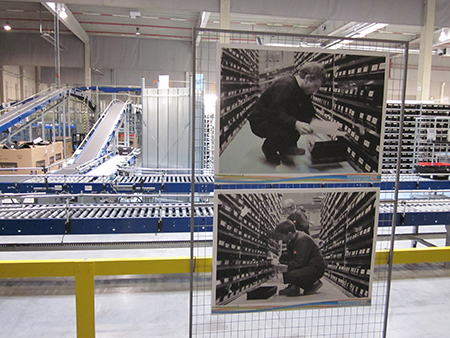Belgian Prime Minister Elio Di Rupo was able to crow at the World Economic Forum in Davos this year, as his nation reaped a host of honors: Belgium was named the fourth most open economy in the world by Ernst & Young’s Globalization Index, while also coming in fourth among 123 countries in the Conference Board’s annual report on worker productivity. A report from Eurostat said Belgium had the highest proportion of innovative companies in Europe after Germany and Luxembourg (albeit in 2008). And Deloitte reported that Belgium has the best R&D-related incentives in all of Europe, as it allows up to 75 percent recovery of withholding tax on researchers’ professional income as long as there is collaboration with a university or research institute.
Clouds on the horizon? Belgium is also in the top five in the EU in wages and labor cost. And its attractive notional interest deduction incentive has been constrained and criticized in recent months, causing the American Chamber of Commerce in Belgium to issue a statement in February to “vigorously defend” the deduction, which attracts foreign investment in Belgium by offsetting a cost of labor and nominal corporate tax rate among the highest in Europe.
“The attack on the notional interest deduction threatens to drive multinational corporations from Belgium, and indeed at least one high-profile company has already decamped,” said Marcel Claes, chief executive of AmCham Belgium. “Of course, it is not only multinational corporations that benefit from NID, but all businesses in Belgium.”
In particular, NID encourages multinational corporations to locate their group financing activities here. “Despite the recent reporting about mailbox companies, the fact is that most of the corporations named by the press have a significant presence in Belgium, creating employment and contributing to public finances,” says Claes. “Instead of attacking these companies, we should work with them to expand their operations in Belgium.”
Those expansions are still coming, across a variety of industries led by life sciences and logistics. Marc Vansteenkiste is senior area manager, North America, for AWEX, the inward investment agency for the French-speaking Wallonia region of Belgium. He says the notional interest deduction (NID) reduces the effective corporate tax rate.
“Almost all U.S. companies are taking advantage of this system,” he says. “I can tell you that we have been working on lots of projects, and the main condition was to get the NID … ‘otherwise we will go elsewhere.’ ” (For the latest on the NID, visit this Web page of the Federal Public Service Finance agency.)

Located in Liege since 2002, Farnell’s European distribution center continues to grow. The British IT products distribution company saw employment at the site grow from 200 to 230 during the financial crisis, and expects to invest up to €4 million over the next three years.
About 200 U.S. companies are in Wallonia, in part because Belgium is such a great test market and bridgehead for Europe. Among the most prominent companies are Caterpillar (in Charleroi), Baxter and Johnson & Johnson. J&J subsidiary Janssen Pharmaceutica recently hosted the prime minister and U.S. ambassador at the opening of a new €49-million (US$65-million) logistics center in La Louvière that will employ 115. It’s not far from a separate medical device and diagnostics distribution center in Courcelles and another in Beerse.
Buck Consultants assisted Johnson & Johnson with the international location search. The firm says the 21,500-sq.-m. (231,432-sq.-ft.) facility centralizes the activities of 15 logistics centers in Europe, with medicines going directly from the manufacturing plants — Beerse (Belgium), Latina (Italy) and Schaffhausen (Switzerland) — to La Louvière, whence they are shipped to Janssen operating companies in 11 European countries as well as to J&J affiliates in the rest of the world. The La Louvière distribution center marks a significant milestone for the implementation of a European integrated distribution network.
“The European distribution center in La Louvière will enable us to more efficiently deliver medicines that respond to the real needs of patients. Thanks to the new structure, some of the logistical burden and administrative costs that hospitals are faced with will also disappear,” said Tom Heyman, CEO of Janssen Pharmaceutica.
A Place for Movement
A report from Cushman & Wakefield has listed Wallonia as the top region for logistics in all of continental Europe. Layers of factors make that rank possible, from being in the crescent of wealth extending from London to Milan, to being in the heart of Europe’s densest networks of roadways and rail. Moreover, the riverport in Liege is the third-busiest after Paris and Duisburg, Germany. Last but not least, for logistics and a host of other sectors, the country is at the crossroads of culture and language, says Vansteenkiste, citing the Wallonian population’s good command of French, Dutch, Italian, English, Arabic and Turkish. A recently established call center near Liege for a Swedish medical device company is a case in point, as the firm was able to find and train people speaking Norwegian, Swedish, Russian and Polish.

Diners at Heliport in Liege look over the Meuse River.
Vansteenkiste says such projects illustrate the region’s economic conversion from traditional industries such as steel to services, R&D, life sciences and logistics. A major example of the latter is TNT’s European hub in Liege, established in 1998, which has grown from 800 employees to approximately 2,000 today, receiving more than 100 million euros in cumulative investment since its opening. Other growing logistics operations in Belgium include a new distribution center from Japanese firm SMC Pneumatics in the Antwerp suburb of Wommelgem, and thriving operations in Wallonia from Coopervision, Dow Corning (in Hainaut), H+M, Skechers, Premier Farnell and Texas-based PFS Web.
Annabelle Kinet, sales and marketing director for the global e-commerce fulfillment company, says the facility, which houses customer service/call center and distribution center functions, serves clients worldwide, including such companies as Xerox, Salomon, Columbia and Procter & Gamble. PFS wanted a centralized solution for serving Europe and Africa, and considered the Netherlands, Germany and the north of France. “But this location was the best one,” she says of the site in Liege, helped by local grants to assist in facility development. She cites the Cushman & Wakefield logistics study:
“Belgium is number one, and the Czech Republic is number five,” she says. “Even if the labor is cheaper in Eastern Europe, with the number of transactions and traffic, it’s better to stay in Western Europe. We have never regretted this choice.”
Even the allegedly high cost of labor is not a deterrent, she says, thanks not only to access to highly qualified individuals, but a reasonable cost savings of between 10 percent and 20 percent compared to the Netherlands or Brussels. The facility serves its clients in six languages. “Also the land and building are cheaper here than in the other countries,” she says. “All these reasons together explain why Belgium is at the top.”
PFS Web employed 180 as of mid-2012. Kinet expects that payroll to reach between 250 and 300 in 2013.
Bernard Piette, manager of Logistics in Wallonia (www.logisticsinwallonia.be), says new assets and programs will add to the sector’s prominence in the region, including the TriLogiPort, a 100-hectare (247-acre) complex with a container terminal located at the Netherlands border near Maastricht and full multimodal service via waterway, rail and road. There’s also the looming possibility of Cargo Rail Express (Carex), or the use of high-speed trains (TGV) for freight. Piette says the project — a collaboration among the five airports at Liege, Paris, London, Amsterdam and Lyon — should be started within the next few years, will full operation before 2020.
Hughes Van Espen, BioLog Europe project manager, is focused on the region’s twin strengths of biotech and logistics. He says the possibility of using Carex for cold chain needs is “interesting for pharma,” not least because of a carbon footprint that would be 35 times less than traditional use of aircraft and trucks. Van Espen’s group is in the midst of an air freight study within the healthcare industry, where temperature control is a major concern. Major companies participating in the study have already seen the benefits of occasionally sharing trucks. Now the idea is to identify enough demand for similar sharing of air cargo flows to attract new flights or belly cargo service.
“All suffer from generics coming in and killing their margins,” says Van Espen, “so they are fighting for every penny.” Analysis of detailed inbound and outbound European cargo data could lead to a collaborative solution.
The Road Ahead for R&D
In November 2012, Deloitte Belgium released “Belgian BioPharma Industry: a major player in the Belgian economy,” a report assembled in cooperation with the Health, Science and Technology Group (HST Group), represented by UCB, GlaxoSmithKline, Janssen Pharmaceutica and Pfizer. According to the analysis, biopharma exports totaled nearly €36 billion (US$48.1 billion) in 2011. The industry represents about 40 percent of private R&D in Belgium and employs approximately 32,000 full-time equivalents.
“Belgium, already a major player in the European biopharmaceutical market, could become the leading country in Europe in this sector,” said Eric Nys, partner at Deloitte Belgium Life Sciences and Health Care Industry leader. “However, there are some vital conditions which must be met: the government attention currently paid to the sector, combined with private commitments, will need to be maintained and further improved.”
Belgium recently attracted a large number of new pharmaceutical investments and ranks third with regard to R&D per capita expenditure in Europe, says Deloitte, driven in part by its strength in clinical trials. But the number of trials is in decline, threatening to further widen the gap between Belgium and top performer Switzerland, where total investment in biopharma R&D in 2010 was more than two and a half times the total in Belgium.
“To avoid Belgium lagging behind, the government will need to maintain and improve the current tax incentives, said Wim Eynatten, International Tax Partner at Deloitte. The Belgian government has proposed setting up five working groups to address the business environment for entrepreneurs in the pharmaceutical sector; protection of intellectual property and market access; support to the Belgian innovative pharmaceutical industry abroad; cooperation with the national Medicines Agency; and a “Stimulus Plan” (employment and education) for the sector.
Meanwhile, regional and institutional support continues unabated. In October, Bio-incubator Leuven opened its second cluster at the Wetenschapspark (science park) Arenberg, with 3,000 sq. m. (32,293 sq. ft.) of tailor-made spaces for R&D-oriented biotech companies. The first cluster of six companies at the park employs 140 people, and three companies have already committed to the new site.
